As usual, I won’t dilly-dally with the information you seek. Instead, I’ll dive into how you can master outreach link building and increase your domain authority.
Shall we get to the details?
What Does Outreach Link Building Entail: A Quick Overview
What Is It?
Outreach link building (also link building outreach) means acquiring backlinks from targeted sources “manually.”
At the core, outreach link building is similar to other tactics SEOs use to get backlinks from bloggers, businesses, and webmasters. They all share the same component:
Link building + outreach
Here is the only difference:
Unlike in other link building tactics, there is more emphasis on “manual outreach” in outreach link building. In fact, the “manual action” is the definitive factor.
Confusing, eh?
Let me explain what I meant…
For example, a linkable asset (like The State of Link Building Report 2022) will earn backlinks even without outreach because it is a vital report SEOs need to win clients or prove a point.
Specifically, the report generated 427 backlinks from 176 websites.
FYI: Authority sites like SEOmustreads (DR 96), Ahrefs (DR 91), Yoast (DR 91), Worderist (DR 91), and Buzzsumo (DR 87) are included in the 176 linking websites.
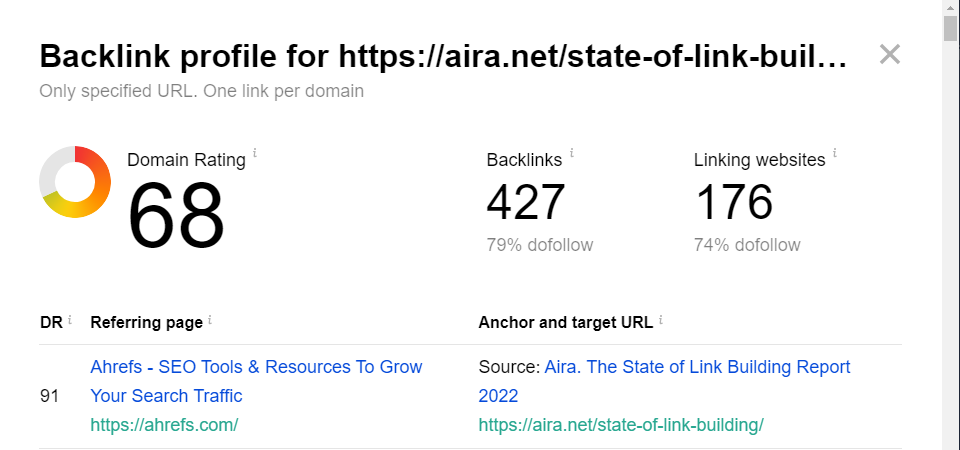
The same principle applies to infographics and skyscraper content.
However, when a backlink strategy involves outreach, it becomes an outreach link building.
In summary: PR, Infographic, or even broken link building can also be “outreach link building.” But there must be an “outreach.”
If you’re still confused, check out how outreach link building works below.
How Does It Work?
Outreach link building is a 3-step process:
Now, let’s dive into each of the processes.
Step 1: Finding Backlink Sources: 3 Easy-to-replicate Strategies
Strategy 1: Guest Posting
Guest posting is simple for experts and beginners. And unsurprisingly, it is the number one way to get backlinks via outreach.
This strategy can be even better if you are an authority in your niche. Say you’re a greenhorn; you can still pull off guest posting. Either way, the steps below will guide you.
▶️ Look for sites accepting guest posts in your niche.
Focus on sites that are actively accepting guest posts. Even better if they have well-written guest post guidelines. That will help you save time.
- Type “guest post” + “niche” into Google search bar

You can change the “guest post” to “guest blog,” “guest author,” “write for us,” or “become a contributor” for a more robust result.
▶️ Select the sites to contact
There’s no point in guest posting on a low-authority site. Your website won’t benefit.
Aim for high-authority websites with better DA/DR/AS scores than yours.
In addition to the authority, check the organic traffic too. The higher the value, the higher the chances of people reading the article and clicking on your backlink.
So, how can you confirm the metrics mentioned?
Use Ahrefs’ Backlink Checker or Semrush’s Domain Overview Tool
I’ll be using Semrush.
- Go to the Domain Overview Tool
Input the domain into the search bar > verify your humanity. You’ll see this:

For the above case: I’ll look for another site because the authority score is too low.
Pro tip: local service niches often have low domain authority. In that case, draft up to 5 target blogs and pick the best 3 — using the DR/AS score and traffic.
▶️ Research interesting topics
Don’t focus on the EASIEST article to house your money keywords. Focus on the target blog.
What topic will be interesting to the readers of the blog? What is the trend of their recently published guest posts?
Use the questions to nail down the article to write.
Want the shortcut I use at this stage?
Look for extra information on the guest post page. Blogs will often state their desired theme.
Databox is an example.
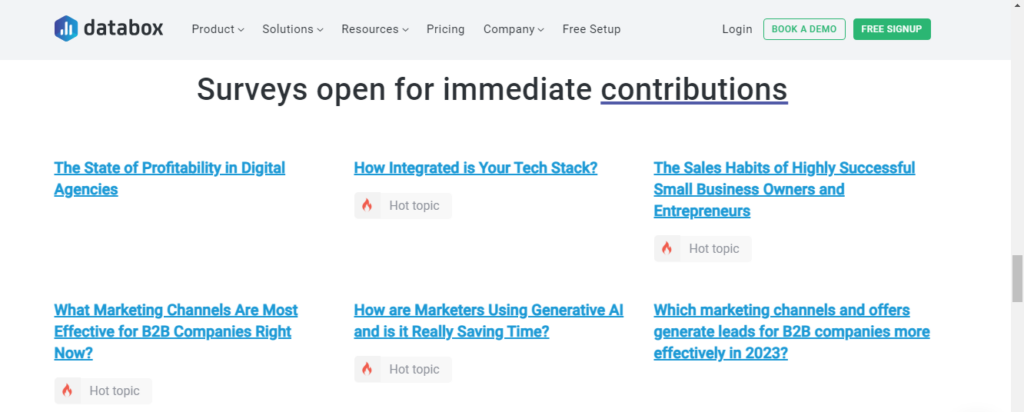
▶️ Pitch and submit the guest post
After the research, pitch your ideas to the target blog. Often, you’ll find a form for this on the guest posting page.
Some blogs might even ask you to send a link to the finished article instead of pitching the idea. Either way, follow the instructions and submit your post.
Strategy 2: Skyscraper Content
This strategy is similar to guest posting. You’ll be writing an article again. However, there is one difference:
The skyscraper strategy is more “rewriting and updating” than “writing.”
In other words, you’ll rewrite articles (with several linking websites) and then promote them.
Sounds hectic, eh?
No — not if you follow the steps below:
▶️ Look for high-ranking articles
- Type your desired keyword into the Google search bar
Note: we’re still using our real estate theme. So, let’s assume the keyword is “how to sell your house fast in London.”
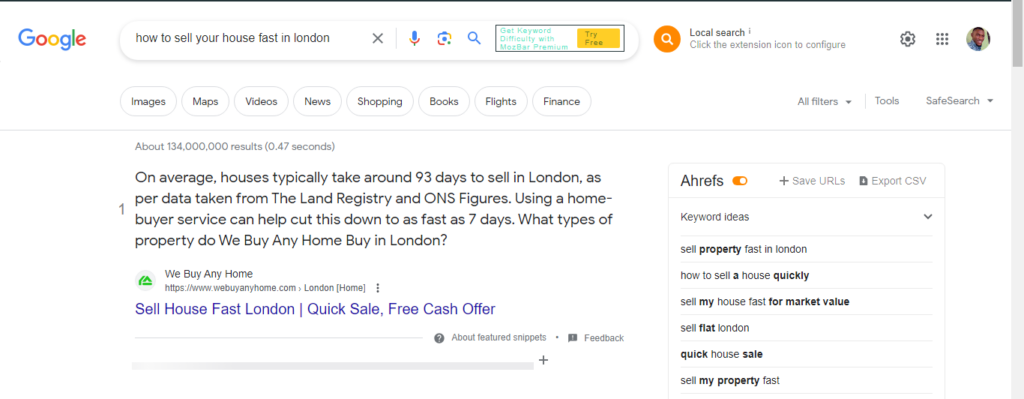
- No. 3 result is more like what we can rewrite. Grab the URL.

▶️ Check the linking websites
- Go to Semrush’s Backlink Analytics tool (or Ahrefs Backlink Checker)
- Insert the URL (the earlier step) into the search bar
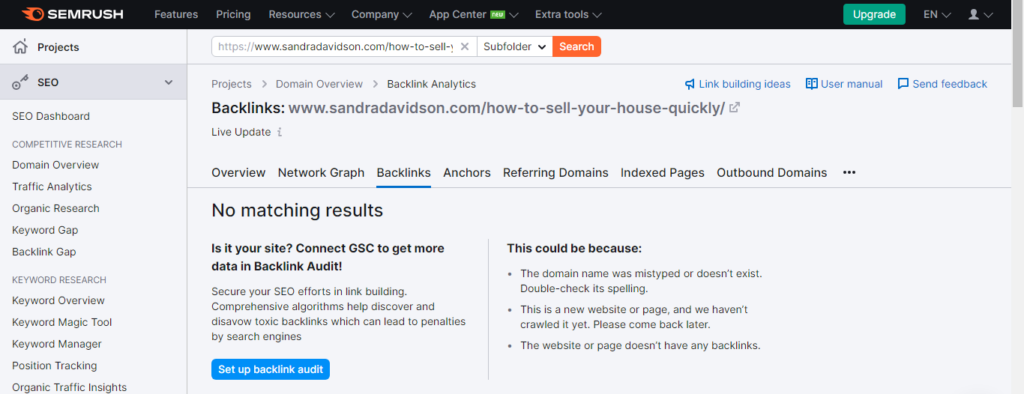
Unfortunately, this sample site also has zero backlinks on Ahrefs.
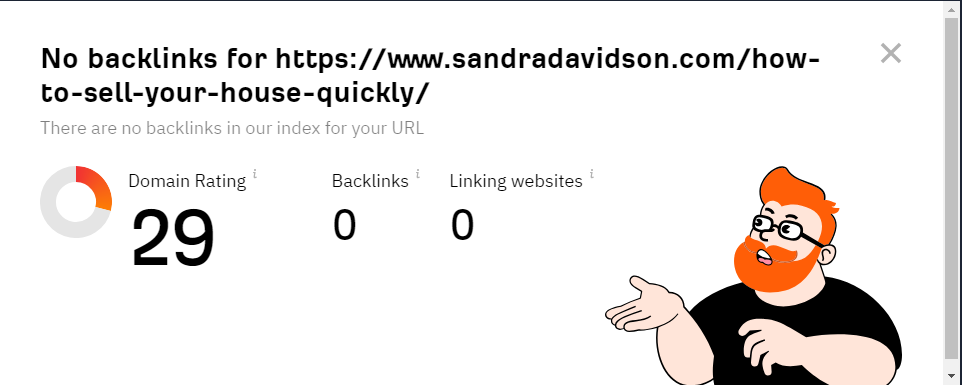
If such happens for your desired keywords, don’t fret. Change the search term to a broad query. In our case, we’ll use the “home buying guide.”
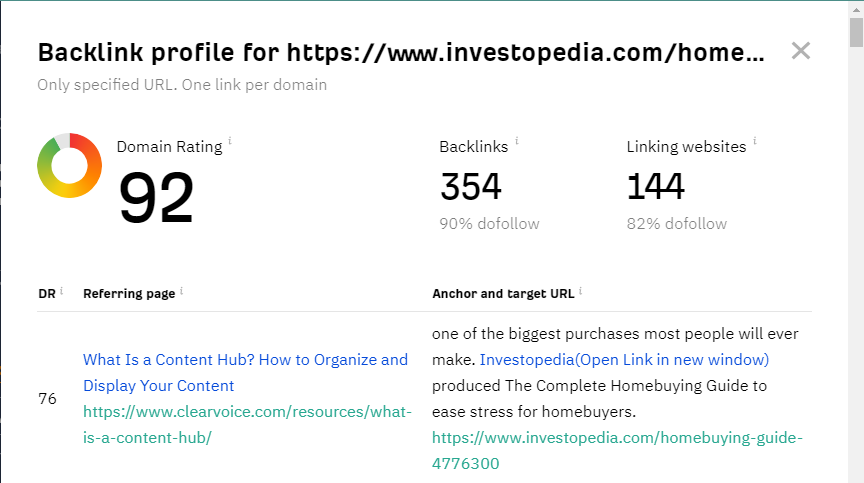
Compile the linking websites into a list. Sort them by their DR/AS.
▶️ Write a better content
Once you settle on the perfect skyscraper content. Analyze it.
What are the strengths of the content? What are the questions yet to be answered? What gaps can you plug?
In the Investopedia “home buying guide,” as an example: there are no pictures, infographics, or case studies. If I’d write that article, I’ll add media files. Also, I’ll ask for quotes from home buyers and add statistics.
That’s how to write better content. Not exactly keyword-stuffing your article or writing unnecessarily long posts.
What next?
Reach out to the referring domains. I’ll explain this part further in the pitching section.
Strategy 3: Broken Link Building (BLB)
This strategy works similarly to skyscraper content. It also involves rewriting an existing article.
However, there is one distinct difference:
BLB, like the name, means the “existing article” is missing. Hence, the “broken link.”
So, how can you do BLB?
I wrote an extensive BLB guide. Check it out; it contains all the details you need.
Now, we have the strategies to locate backlink sources. Let’s find their email addresses.
Step 2: Get the Email Addresses of Your Target Sources
Often, you can connect with bloggers, influencers, or webmasters on their websites or social media. Unfortunately, there is one sideline to those channels:
You might never get a reply. And if you do get one, it’ll come late.
On the other hand, emails have a higher chance of being seen and read.
So, how do you find the golden doorway (email address) to your backlinks?
- Manual scraping (with Google & LinkedIn), or
- Using email finders (tools)
Manual Scraping
- Type “insite: the URL + author” into the Google search bar. You’ll see something like this:
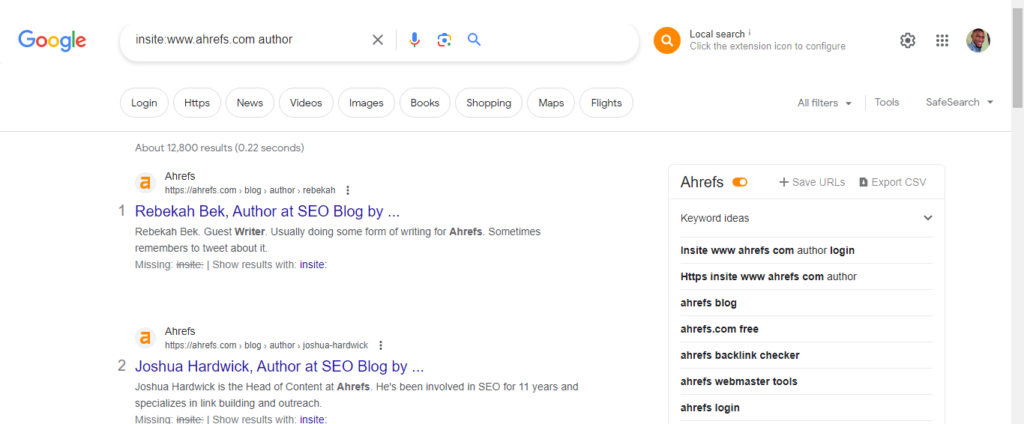
Pro tip: you can change “author” to editor” or “writer” for more results.
- Go to Chrome Web Store > download GetProspect > Sign up for a free account with your Gmail.

- Go to Linkedin > type in the name of the author > people > mark it on the GetProspect list > save leads
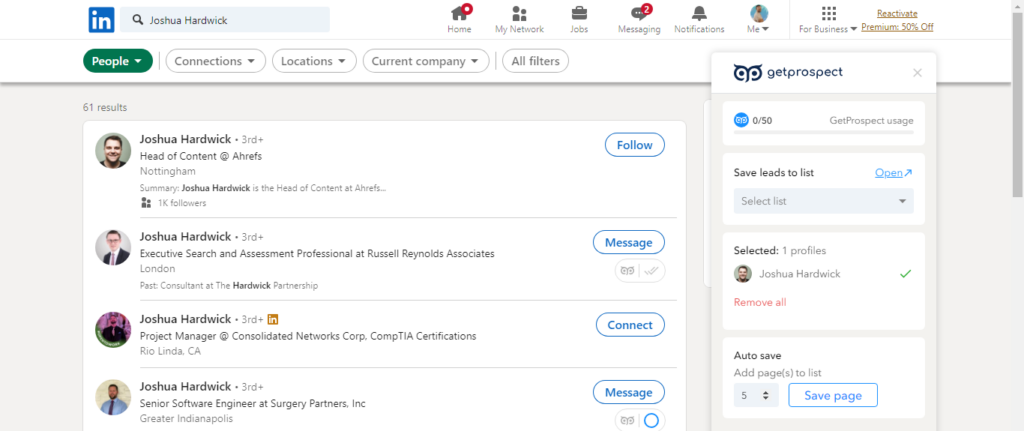
- Click on the author’s name on the GetProspect bar. You’ll see a new tab like this with the email address you seek:

- Copy the email address for later use.
Note: GetProspect, while free, is limited. You can only use it to find 50 emails per month. So, use the freemium wisely.
Using Tools
The manual scraping can be lengthy, especially when you plan outreach in scale. In that case, you need email finders.
Here are the top ones I use:
Note: whether manually or with tools, verify email addresses before pitching. Here’s how to do that:
- Verify with GetProspect, or
- Use Wiza’s free email verifier
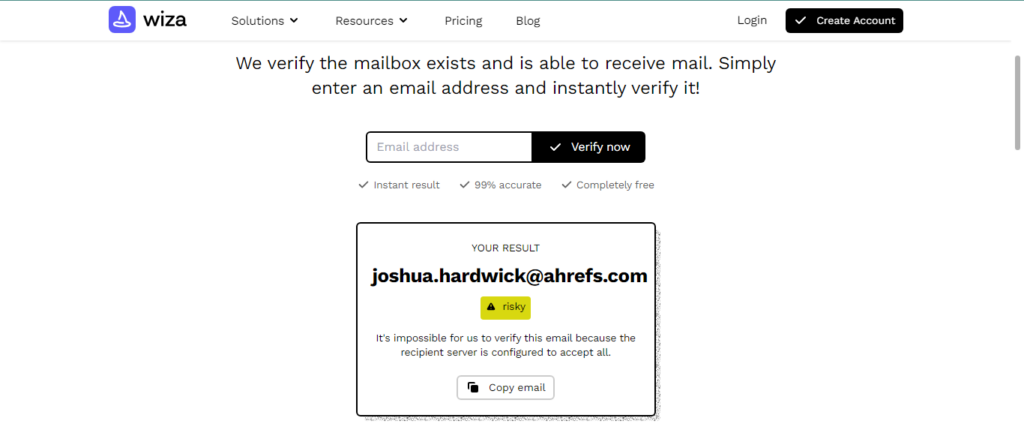
Proceed only with “valid” email addresses — not “accept all.” If there are no valid addresses for the authors, contact other people in the company.
Step 3: Pitching Like a Pro — Tips & Templates
Pitching is the hardest part of outreach link building. Of course, you can guess why:
You’re sending the pitches to humans. And we can be extra demanding.
Even at that, you can still get a successful pitch game on. Present your ideas as short as possible and focus on the target.
More importantly, ensure your message contains the necessary ingredients.
The 3 ingredients of a good pitch:
- Introduction — introduce yourself (in relation) to the target.
- Offer — don’t just say you can write an article for your target; create a need.
- Your request — fill the void you created and position yourself as the right fit.
I know the ingredients sound theoretical. How about we see them in action?
Learn From How Pros Pitch
Check this out:
Which of these two pitches will you reply:
❌️ Don’t be this guy!
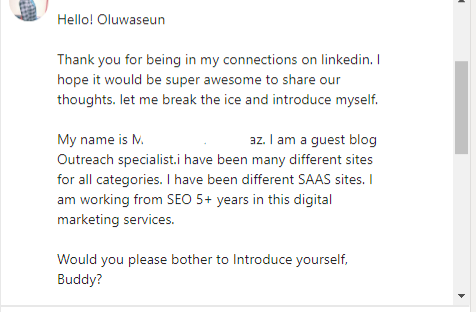
Why?
❌️ The hustle spirit is encouraging. But bro, you don’t even know me!!!
❌️Why not take some time to check out my profile and read about me?
❌️ The CTA is wrong. He might even come off as lazy. How could I trust this “specialist”?
❌️ Besides, there is no offer or request — asking your target to introduce themselves is not good enough.
✅️ I love this guy; be like him — he’s a pro…
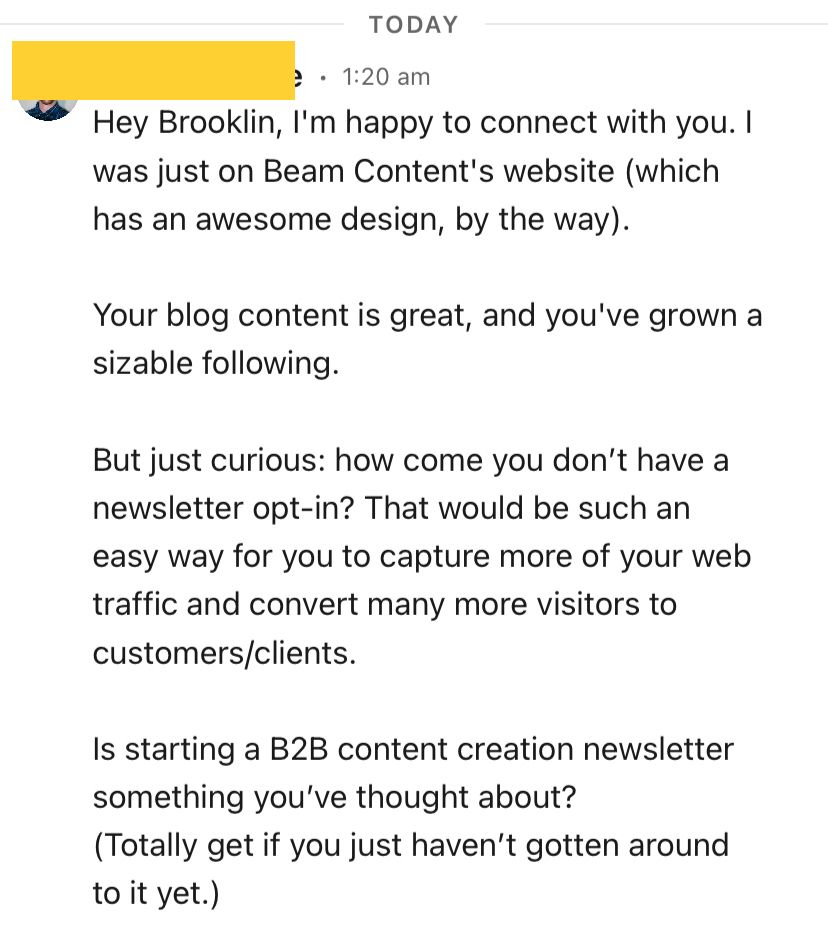
Why?
The guy didn’t even introduce himself or ask for sales? Why is the pitch good without those ingredients?
For starters, know this:
The best outreach doesn’t seem like outreach. It warms up the prospects and lessens all their defenses.
When the defense is down, the pitcher can attack with his case studies and the request. At this point, the chances of non-response are slim.
That said, let’s see what made the pitch good:
✅️ The guy made the message all about the target. He even complimented the design of the website.
✅️ The pitcher did thorough research to create a need. To arrive at the conclusion (of no newsletter opt-in), he must have surfed the blog randomly at least 5 times.
✅️ The pitcher created a need and provided the benefits of having the need filled.
✅️ The CTA at the end is 100% friendly, warm, with zero sales attitude.
When the target replies (and he did — see screenshot below), the pitcher can now provide case studies and properly introduce himself. This is called an email outreach sequence.
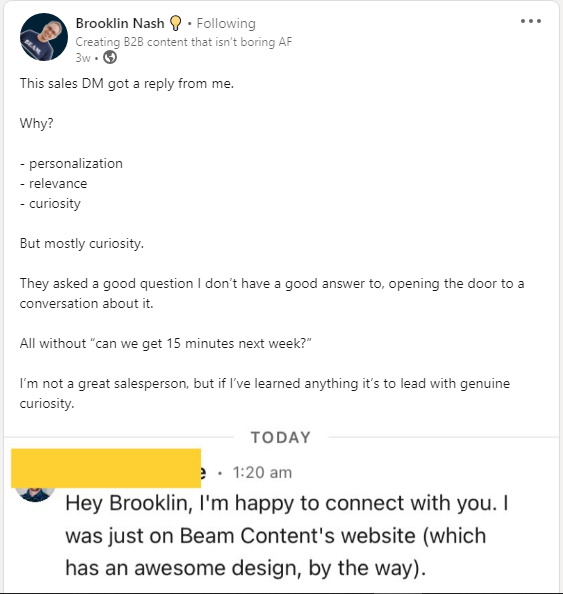
Will you love to write your outreach pitches like the pro above?
Learn and practice with the templates below.
3 Templates You Can Copy, Improve & Use
▶️ Template 1 for guest posting
Hi [first name],
I’ve been an avid reader of your blog for X months/years. Love how you’ve grown over the years — from the days of [name of the article with less research] to [the article with in-depth reporting].
Thanks for all the insights.
When I saw that you started accepting guest posts, I was excited. And fortunately, I can help with [name of the hot topics the target listed as needed].
Beyond being a long-time fan and subscriber who knows your writing guidelines, I know the [topic]. I own A [name of your company or past employer] and did B and C [establish your authority over the piece you’d like to write about].
The best part: I’d already drafted the outline for the post. Check it out:
[Insert link to an editable Google document]
Is this a topic you’d like to include on your blog?
I’d like to further discuss how we can rank this post on the first page on Google to draw more traffic.
[Add your email signature]
▶️ Template 2 for skyscraper content
Hi [first name],
I noticed your recent blog post about [name of the article where the skyscraper content was linked]. I couldn’t agree more on [mention a particular insight in the post].
BTW, you linked out to [name of the skyscraper content]. But do you know most of the details included in that study are outdated now?
I wrote an updated post [link to it] about the same article — supported by quotes from SMEs and recent statistics. It may be of interest to you.
— Keep up the good work
[Add your email signature]
▶️ Template 3 for BLB
Hi [first name],
I was reading your blog post on [name the article — hyperlink it also]. I noticed the destination of this link [the anchor text and its position] is missing.
I created the same article that might interest you. Check it out below:
[Insert link to an editable Google document]
— Regards
[Add your email signature]
How to Manage Non-response or Rejection When You Pitch
You might never get a reply despite crafting the best offer. It happens to the best of us. So, don’t fret.
Instead, follow up on your initial message. This is more the reason you should focus on warming up prospects. It allows you to follow up warmly.
More importantly, follow up the right way. Here is a guide:
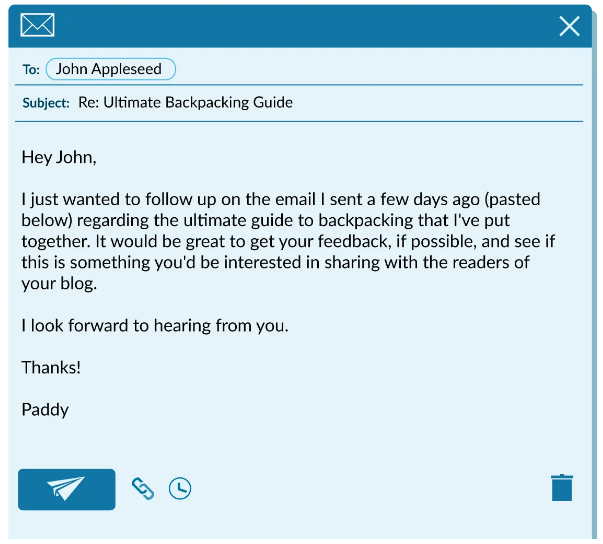
Source: Moz
Lastly, check the time you pitch. Monitor the time zone of the target. Schedule your posts to office hours in the early days of the week (Mondays and Tuesdays).
What if you still get rejected or ignored after all the due diligence?
It happens. Move on to the next prospect!
Want to learn how I’ve been writing outreach emails since 2013?
Check it out below.
A quick peek inside:
You’ll learn the ABC of successful pitching for outreach — everything from the subject line to the closing signature.
Why should you care?🤔
I arrived at the tips in this article after 2500+ pitches (for myself and clients) with a >30% success rate. You sure can learn from that.
Let’s begin already…
Before Writing Your Outreach Email
Spoiler alert: no author, blogger, journalist, or webmaster cares about you. It is all about what they can get from you. So, make your outreach all about them.
- Does your content align with the target’s goals?
- What’s unique about your article?
- Is your take controversial, data-rich, detailed, or humorous?
Otherwise, don’t proceed with this article. Fix the basics.
Done?
Let’s craft the perfect outreach link building email.
Mastering the 5 Parts of an Outreach Email
Subject Line
No one will open a poor subject line. It might even get deleted right there from the notifications tab.
Worst case: your email will go straight into the spam folder. This can happen when recipients manually add you or automatically.
Either way, being in the spam box is BAD for outreach success. Avoid it by all means. But how?
How can you avoid your messages getting deleted or ending up in the graveyard of spam?
Write a good subject line.
Here’s how I write good subject lines:
✅️ I keep it concise
❌️ I don’t yell — if you don’t already know, upper case letters can come off as yelling. I only use it sparingly, if at all.

✅️ I am upfront about the offer — avoid click baits like “re:” or deceiving readers only to say it’s only a joke.
❌️ I never include spam-like phrases like “link exchange or link request. That would be too lazy. I wouldn’t open such emails either.
Pro tip: I don’t recommend using preheaders (secondary subject lines) within the email copy. But if you must, don’t repeat your subject line.
Instead, make your preheaders a continuation or subtitle of the subject line.
Email Body
Starting off with the greeting, don’t be generic. Personalize the email copy to the recipient, the company, and even the location (where possible).
About the recipient, mention their first names. Don’t know it?
Don’t pitch!
But seriously, address your recipient by their first name. If you don’t know it, follow these tips:
- Check the byline of the landing post that attracted you to the site/blog
- Check the about page of the site/blog
- Check the company info on LinkedIn > find employees working there
If you can’t find the author’s details, even after the 3 steps above, you can use “hi there.” Never send “hi, blogger,” “hi, content manager,” or “hi, webmaster.” Else, you’ll land right in the spam folder.
Moving on to the next phase: the intro line.
As early as possible, share a mutual interest. It might be what you like about the author’s last post or their tone or style of writing.
Also, the intro line is the perfect place to state whether your client’s company is in the same country or city as the author.
Either way, establish interest in the intro line. Write as if you are talking to a stranger at the park or pub.
Here’s a quick summary of the places I look to draw interest:
- Blog posts
- Tweets/retweets and posts on LinkedIn
- About Us page or bio on X and LinkedIn
Now, moving to the second paragraph: the problem statement.
State the issues you find in the post or the website. Please, while you’re at it, include the “why.”
E.g.,
While your post is insightful and engaging, you didn’t optimize it for social sharing. Do you know that you can summarize the highlights into infographics, and people can easily share that?
Moving on to the outreach link building part of your email: the ask?
The simple hack I use here is to continue with the problem statement questions. Then, I move subtly into the “real” pitch.
E.g.,
Is creating infographics a tad too much work? What if there’s already one that already captures your highlights and matches your style and tone?
Would you be interested?
Call To Action (CTA)
Undoubtedly, CTAs are great. But you can expand and experiment with calls to benefits & emotions.
Instead of:
❌️ Click here to view the infographics
❌️ Download the loan calculator here
❌️ Check out this replacement page
❌️ Check out this statistics page
❌️ Check out this related guest post
Try this:
✅️ Increase your social share with this infographic
✅️ Add more subscribers to your email list with this loan calculator
✅️ Increase your search engine rankings with this replacement page
✅️ Build relevance and popularity in your niche with this statistics page
✅️ Enhance your topical authority with this guest post
What do you think?
Are the second options not better?
Closing Remark
The “ask” is done. Now, sign out professionally. And FYI, I’m not talking about “best regards” or “sincerely.”
You can do better.
Specifically, use an email signature. You’re likely representing a client. Let that reflect in the signature. But why?
Email signatures are not only professional. They show you’re a “real” person from a reputable company.
That said, here are the elements I include in my email signatures — that you should too:
- Full name
- Job title
- The name of the website and logo
- The social media accounts — limit these to just three: LinkedIn, X (formerly Twitter), and the platform where the author/blogger is most active.
- The phone number
Follow Up
Despite perfecting your outreach pitch, your messages might never get replied to. Don’t fret. You’re probably just sending the emails on the wrong day.
Is there a right day?
Not exactly. But messages get opened on some days and times more than others.
Authority Hacker sent 600K+ outreach link building emails to 150K+ websites. They found that the best days to send messages are Mondays and Fridays.
So, what happens if you send your messages on Mondays and Fridays and they aren’t opened or replied to?
The author/blogger might probably be busy. They might be handling other pitches just like yours. Exercise patience.
For me, I wait 5-6 days before following up. But you might need to confirm that the author hasn’t already linked to your page.
So, before follow-up, do a quick backlink audit. Check to see if there are any new backlinks to your target URL or content.
If there are no new backlinks, send your follow-up message. For me, I keep it simple and reply to my original email.
Here is an example:
Re: Have you considered using infographics to boost your traffic?
Hi [first name],
I’m only following up on the email I sent 5 days ago about the infographic I designed for your* [title of post — hyperlink].
I would appreciate your feedback. Is it something you’d share with your readers?
Look forward to your reply.
Thanks,
-Seb
What if the author didn’t reply after the follow-up?
Frankly, I only send one follow-up. It doesn’t make sense to me, at least, to follow up on another follow-up. That would be 10 days wasted when I know an interested blogger would already link to my page in 8 days.

But you can try up to 3 times. The folk at Authority Hacker do 3 follow-ups.

Can’t do manual follow-ups?
Use Boomerang. It’s a Gmail plugin that sends your message back to you after a set time (hours or days) if there is no response.
Plus, Boomerang is free.
Additional Tips to Master Outreach Link Building Emails
Use A Work Email Address
Work email addresses are just more professional than the regular ones. Plus, it would have the website’s name you’re pitching from. And that’s better than Gmail or Yahoo Mail.
And FYI, I’m still only referring to link building for personal gains.
For third-party projects or clients, use their company’s work email address. In other words, if you’re doing outreach for Ahrefs, send your email using [email protected].
In rare cases where the client’s work email address isn’t available, you can do outreach with a regular or personal email address.
Be Careful With Automation
Don’t get me wrong, there is nothing wrong with automation. In fact, I use it with canned responses.
However, I’ll advise moderation. Why?
For starters, mass emailing is not really applicable to link building. Unlike other cold pitching, your creativity is tied to your author. And unfortunately, two authors can’t be the same — the interest line and the problem. Hence, the reason for manual outreach.
Besides, it’s illegal to mass email people without their consent. More importantly, a mistake with mass email is at scale and can’t be corrected.
And please, don’t resort to the unpleasant tactic marketers use: making mistakes intentionally so that they can send another message afterward.
Lastly, don’t spin templates with AI tools. You can adapt templates but add your spin to them manually.
Don’t Neglect Negative Responses
Spending hours crafting the perfect pitch and waiting 5 days for a follow-up only to get a no can be frustrating. You might never want to reply to the message.
Honestly, I get how you’re feeling. But don’t ignore feedback. Instead, milk it. A negative feedback can be an opportunity. How so?
If a blogger takes time to reply to your outreach email, you probably got some things right. Hello, your message was opened. Thumbs up.
Now, build on that response. Your current work might not interest the blogger. The next one might.
So, how do you build on the negative feedback?
- Thank the blogger for their honest reply
- Ask why they are not interested if the reason is not included in the message.
- Ask their opinion on how to improve the content.
- Also, ask if the issue is that the blogger couldn’t take the time to write a post to link to you. You might also score a content writing gig.
- Most importantly, ask if the blogger knows someone who might be interested in your content.
Practice, Practice & Practice Again
No one mastered outreach link building and pitch on their first trial. I didn’t. Cut yourself some slack.
Dust yourself up. Personalize your message, and be helpful, curious, and concise. Try again and again. You’ll get some results.
Need to Scale Your Outreach Link Building?
You can use outreach tools like Respona to build quality backlinks at scale. Also, you can complement that with Zapier for automation.
Either way, you must master the foundational knowledge of outreach link building, as I’ve explained earlier in this article.
Otherwise, you’d miss tons of leads and waste money on subscriptions.
Also, you outsource the process to experts and focus on other parts of your digital business.
Further reading: How To Increase Domain Authority

